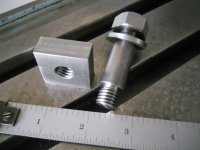catalytic
Cast Iron
- Joined
- Feb 4, 2010
- Location
- Boston, Los Angeles, and Cleveland
I just picked up a Rusnok milling machine and need to get some T-nuts to fit.
The manual and all of the specs literature online says the T-slots are 5/8" nominal, which I don't believe after measuring it and seeing a post by someone else on another forum that said 9/16" nominal. Here are my measurements (just done with a digital caliper held in an awkward way, so figure +/- 0.005")
My measurements don't appear to match anything in the Te-Co catalog, so I'm thinking about buying & cutting down the next size up, which is 0.005" wider than the narrow part of the T-slot and 0.027" wider than the wide part.
So:
-Is there a standard nominal size that is a good fit (i.e. am I way off here)? (I'd rather not spend time making stupid stuff like T-nuts)
-What amount are the dimensions of the nuts supposed to be undersize compared to the slot?
-Are Te-Co nuts hardened?
 [/quote]
[/quote]
The manual and all of the specs literature online says the T-slots are 5/8" nominal, which I don't believe after measuring it and seeing a post by someone else on another forum that said 9/16" nominal. Here are my measurements (just done with a digital caliper held in an awkward way, so figure +/- 0.005")
My measurements don't appear to match anything in the Te-Co catalog, so I'm thinking about buying & cutting down the next size up, which is 0.005" wider than the narrow part of the T-slot and 0.027" wider than the wide part.
So:
-Is there a standard nominal size that is a good fit (i.e. am I way off here)? (I'd rather not spend time making stupid stuff like T-nuts)
-What amount are the dimensions of the nuts supposed to be undersize compared to the slot?
-Are Te-Co nuts hardened?
 [/quote]
[/quote]




